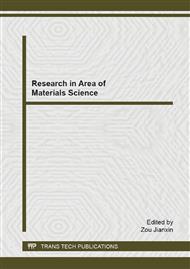[1]
P. Acker, Z. P. Bažant, J. C. Chern, C. Huet, F. H. Wittman, RILEM Recommendation on Measurement of Time-Dependent Strains of Concrete, Materials and Structures, 31, 212(1998), 507-512.
Google Scholar
[2]
D. McHenry, A New Aspect of Creep in Concrete and Its Applications to Design, Proc. ASTM, 43(1943), 1069-1084.
Google Scholar
[3]
A. M. Neville, W. H. Dilger, J. J. Brooks, Creep of Plain and Structural Concrete, Construction Press, London and New York, 1983, p.361.
Google Scholar
[4]
Z. P. Bažant, L. Panula, Practical Prediction of Time-Dependent Deformations of Concrete; Part 2: Basic Creep, Materials and Structures, 11, 65(1978), 317-328.
DOI: 10.1007/bf02473873
Google Scholar
[5]
ACI Committee 209, Prediction of Creep, Shrinkage and Temperature Effects in Concrete Structures ( ACI 209R-92), Farmington Hills, Mich., 1992, p.47.
Google Scholar
[6]
H. S. Muller, H. K. Hilsdorf, Evaluation of the Time-Dependent Behavior of Concrete, Summary Report on the Work of General Task Group 9, CEB Bulletin d' Information, 199(1990), p.290.
Google Scholar
[7]
Z. P. Bažant, S. Baweja, Creep and Shrinkage Prediction Model for Analysis and Design of Concrete Structures, The Adam Neville Symposium: Creep and Shrinkage-Structureal Design Effects, SP-194, A. Al-Manaseer, ed., American Concrete Institude, Farmington Hills, Mich., 2000, pp.1-100.
DOI: 10.14359/9890
Google Scholar
[8]
Gardner, M. J., and Lockman, M. J., Design Provisions for Drying Shrinkage and Creep of Normal-Strength Concrete, ACI Materials Journal, 98, 2( 2001), 159-167.
DOI: 10.14359/10199
Google Scholar
[9]
M.X. Ye, J.A. Cao, et al, Long-term Deformation of Prestressed Concrete Beams with Ballastless Track and Its Influencing Factors, Journal of Central South University (Science and Technology), 42, 6(2011), 1756-1763.
Google Scholar
[10]
T.M. Ahlborn, C.K. Shield, C.W. French, High-performance Concrete Prestressed Bridge Girders: Long Term and Flexural Behavior, Report 2000-32, Minnesota Department of Transportation, St. Paul, MN 91.
Google Scholar
[11]
D.J. Kelly, T.E. Bradberry, J.E. Breen, Time Dependent Deflections of Pretensioned Beams. Research Report CTR 381-1, Center for Transportation Research – The University of Texas at Austin.
Google Scholar
[12]
J. Wang, S.Y. Shang, et al, Experimental Study on Long-term Deformation of Prestressed Concrete Beam with Pretensioned Bent-up Tendons, Concrete Products, 7(2013), 110-113.
Google Scholar
[13]
H. O. Byhung, H. Y. In, Sensitivity Analysis of Time-Dependent Behavior in PSC Box Girder Bridges, Journal of Structural Engineering, ASCE, 126, 2(2000), 171-179.
DOI: 10.1061/(asce)0733-9445(2000)126:2(171)
Google Scholar
[14]
W. C. Xue, T. Liu,W. Wang, Y.M. Hu, Creep Behavior of High-speed Railway Prestressed Concrete Girders for 500 Days, ACI Structural Journal,108, 4 (2011), 497-504.
DOI: 10.14359/51682991
Google Scholar
[15]
The Professional Standards Complication Group of People's Republic of China, Code for Design of Highway Reinforced Concrete and Prestressed Concrete Bridges and Culverts (JTG D62-2004), China Communications Press, Beijing, China, 2004, 231pp.
Google Scholar
[16]
TB 10002. 3-2005, Code for Design on Reinforced and Prestressed Concrete Structure of Railway Bridge and Culvert, Beijing: China Railway Publishing House, (2005).
Google Scholar
[17]
JTG D62-2004, Code for Design of Highway Reinforced Concrete and Prestressed Concrete Bridges and Culverts, Beijing: China Communications Press, (2004).
Google Scholar
[18]
GB 50010-2010, Code for design of concrete structures, China Architecture & Building Press, (2010).
Google Scholar
[19]
ACI Committee 318, Building Code Requirements for Structural Concrete (ACI 318-11) and Commentary, American Concrete Institute, Farmington Hills, MI, 2011, 465pp.
DOI: 10.1061/(asce)1076-0431(1996)2:3(120.3)
Google Scholar
[20]
T. Liu, The Experimental and Theoretical Studies on Long-term Behavior of New Type of Prestressed Concrete Beams, Tongji University, (2012).
Google Scholar


